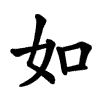Definify.com
Definition 2025
出
出
| ||||||
|---|---|---|---|---|---|---|
Translingual
| Stroke order | |||
|---|---|---|---|

| |||
Han character
出 (radical 17 凵+3, 5 strokes, cangjie input 山山 (UU), four-corner 22772, composition ⿱屮凵)
References
- KangXi: page 135, character 11
- Dai Kanwa Jiten: character 1811
- Dae Jaweon: page 301, character 7
- Hanyu Da Zidian: volume 1, page 307, character 8
- Unihan data for U+51FA
Chinese
| trad. | 出/齣 | |
|---|---|---|
| simp. | 出 | |
| 齣 - "classifier for operas, plays" only | ||
Glyph origin
| Historical forms of the character 出
| |||
|---|---|---|---|
| Oracle bone script | Bronze inscriptions | Large seal script | Small seal script |
 |
 |
 |
 |
| Characters in the same phonetic series (出) (Zhengzhang, 2003) | |
|---|---|
| Old Chinese | |
| 聉 | *r̥ʰuːlʔ, *ŋrɯd, *ʔr'uːd, *ŋruːd |
| 贅 | *kljods |
| 祟 | *sqʰluds |
| 出 | *kʰljuds, *kʰljud |
| 茁 | *ʔl'ɯd, *skruːd, *skrod, *skrud |
| 欪 | *qʰlɯd, *l̥ʰud |
| 貀 | *ŋr'uːd |
| 袦 | *ŋr'oːd |
| 咄 | *ʔl'oːd, *ʔl'uːd |
| 柮 | *sɡloːd, *ʔl'uːd |
| 拙 | *kljod |
| 炪 | *kljod, *l̥ʰud |
| 掘 | *ɡlod, *ɡlud |
| 鈯 | *l'uːd |
| 啒 | *kluːd, *qʰluːd |
| 淈 | *kluːd, *ɡluːd |
| 窟 | *kʰluːd |
| 泏 | *kʰluːd, *ʔl'ud |
| 堀 | *kʰluːd, *ɡlud |
| 朏 | *kʰluːd, *pʰlɯːlʔ, *pʰlɯːls, *pʰlɯlʔ |
| 窋 | *ʔl'ud |
| 絀 | *ʔl'ud |
| 黜 | *l̥ʰud |
| 屈 | *klud, *kʰlud |
| 趉 | *klud |
| 鶌 | *klud |
| 詘 | *kʰlud |
| 倔 | *ɡlud |
| 崛 | *ɡlud, *ŋɡlud |
Uncertain. For dictionary purposes the bottom element is analyzed as 凵 (“container”). The top element resembles 屮 (“sprout”), thus analysed by many as "sprout emerging". Oracle bones character may represent a "foot coming out of an enclosure".
Pronunciation
- Mandarin
- Cantonese (Jyutping): ceot1
- Hakka (Sixian, PFS): chhut
- Min Dong (BUC): chók
- Min Nan
- Wu (Wiktionary): tsheq (T4)
- Mandarin
- (Standard Chinese, Beijing)+
- Pinyin:
- Zhuyin: ㄔㄨ
- Wade-Giles: ch'u1
- Gwoyeu Romatzyh: chu
- IPA (key): /ʈ͡ʂʰu⁵⁵/
-

- (Standard Chinese, Beijing)+
- Cantonese
- (Standard Cantonese, Guangzhou)+
- Jyutping: ceot1
- Yale: chēut
- Cantonese Pinyin: tsoet7
- IPA (key): /t͡ɕʰɵt̚⁵/
- (Standard Cantonese, Guangzhou)+
- Hakka
- (Sixian, incl. Miaoli and Meinong)
- Pha̍k-fa-sṳ: chhut
- Hakka Romanization System: cud`
- Hagfa Pinyim: cud5
- IPA: /t͡sʰut̚²/
- (Sixian, incl. Miaoli and Meinong)
- Min Dong
- (Fuzhou)
- Bàng-uâ-cê: chók
- IPA (key): /t͡sʰouʔ²⁴/
- (Fuzhou)
- Min Nan
- (Hokkien)
- Pe̍h-ōe-jī: chhut
- Tâi-lô: tshut
- Phofsit Daibuun: zhud
- IPA (Xiamen): /t͡sʰut̚³²/
- IPA (Quanzhou): /t͡sʰut̚⁵/
- IPA (Zhangzhou): /t͡sʰut̚³²/
- IPA (Taipei): /t͡sʰut̚³²/
- IPA (Kaohsiung): /t͡sʰut̚³²/
- (Teochew)
- Peng'im: cug4
- Pe̍h-ōe-jī-like: tshuk
- IPA (key): /t͡sʰuk̚²/
- (Hokkien)
- Wu
- (Shanghainese)
- Wiktionary: tsheq (T4)
- IPA (key): /t͡sʰəʔ⁵⁵/
- (Shanghainese)
- Dialectal data▼
| Variety | Location | 出 |
|---|---|---|
| Mandarin | Beijing | /ʈ͡ʂʰu⁵⁵/ |
| Harbin |
/ʈ͡ʂʰu⁴⁴/ /ʈ͡ʂʰu²⁴/ ~去 |
|
| Tianjin |
/ʈ͡ʂʰu²¹/ /t͡sʰu²¹/ |
|
| Jinan | /ʈ͡ʂʰu²¹³/ | |
| Qingdao | /tʃʰu⁵⁵/ | |
| Zhengzhou | /ʈ͡ʂʰu²⁴/ | |
| Xi'an | /p͡fʰu²¹/ | |
| Xining | /ʈ͡ʂʰv̩⁴⁴/ | |
| Yinchuan | /ʈ͡ʂʰu¹³/ | |
| Lanzhou | /p͡fʰu¹³/ | |
| Ürümqi | /ʈ͡ʂʰu²¹³/ | |
| Wuhan | /t͡ɕʰy²¹³/ | |
| Chengdu | /t͡sʰu³¹/ | |
| Guiyang | /t͡sʰu²¹/ | |
| Kunming | /ʈ͡ʂʰu³¹/ | |
| Nanjing | /ʈ͡ʂʰuʔ⁵/ | |
| Hefei | /ʈ͡ʂʰuəʔ⁵/ | |
| Jin | Taiyuan | /t͡sʰuəʔ²/ |
| Pingyao | /t͡sʰuʌʔ¹³/ | |
| Hohhot | /t͡sʰuəʔ⁴³/ | |
| Wu | Shanghai | /t͡sʰəʔ⁵/ |
| Suzhou | /t͡sʰəʔ⁵/ | |
| Hangzhou |
/t͡sʰəʔ⁵/ /t͡sʰz̩ʷəʔ⁵/ |
|
| Wenzhou | /t͡ɕʰy²¹³/ | |
| Hui | Shexian | /t͡ɕʰyʔ²¹/ |
| Tunxi | /t͡sʰə⁵/ | |
| Xiang | Changsha | /t͡ɕʰy²⁴/ |
| Xiangtan | /t͡ɕʰy²⁴/ | |
| Gan | Nanchang | /t͡sʰɨʔ⁵/ |
| Hakka | Meixian | /t͡sʰut̚¹/ |
| Taoyuan | /tʃʰut̚²²/ | |
| Cantonese | Guangzhou | /t͡sʰøt̚⁵/ |
| Nanning | /t͡sʰyt̚⁵⁵/ | |
| Hong Kong | /t͡sʰøt̚⁵/ | |
| Min | Xiamen (Min Nan) | /t͡sʰut̚³²/ |
| Fuzhou (Min Dong) | /t͡sʰouʔ²³/ | |
| Jian'ou (Min Bei) | /t͡sʰy²⁴/ | |
| Shantou (Min Nan) | /t͡sʰuk̚²/ | |
| Haikou (Min Nan) | /sut̚⁵/ |
| Rime | ||
|---|---|---|
| Character | 出 | 出 |
| Reading # | 1/2 | 2/2 |
| Initial (聲) | 昌 (24) | 昌 (24) |
| Final (韻) | 脂 (16) | 術 (52) |
| Tone (調) | Departing (H) | Checked (Ø) |
| Openness (開合) | Closed | Closed |
| Division (等) | III | III |
| Fanqie | 尺類切 | 赤律切 |
| Reconstructions | ||
| Zhengzhang Shangfang |
/t͡ɕʰiuɪH/ | /t͡ɕʰiuɪt̚/ |
| Pan Wuyun |
/t͡ɕʰʷiH/ | /t͡ɕʰʷit̚/ |
| Shao Rongfen |
/t͡ɕʰjuɪH/ | /t͡ɕʰjuet̚/ |
| Edwin Pulleyblank |
/cʰwiH/ | /cʰwit̚/ |
| Li Rong |
/t͡ɕʰuiH/ | /t͡ɕʰiuĕt̚/ |
| Wang Li |
/t͡ɕʰwiH/ | /t͡ɕʰĭuĕt̚/ |
| Bernard Karlgren |
/t͡ɕʰwiH/ | /t͡ɕʰi̯uĕt̚/ |
| Expected Mandarin Reflex |
chuì | chu |
| Baxter-Sagart system 1.1 (2014) | ||
|---|---|---|
| Character | 出 | 出 |
| Reading # | 1/2 | 2/2 |
| Modern Beijing (Pinyin) |
chū | chuì |
| Middle Chinese |
‹ tsyhwit › | ‹ tsyhwijH › |
| Old Chinese |
/*t-kʰut/ | /*t-kʰut-s/ |
| English | go or come out | bring or take out |
Notes for Old Chinese notations in the Baxter-Sagart system: * Parentheses "()" indicate uncertain presence; | ||
| Zhengzhang system (2003) | ||
|---|---|---|
| Character | 出 | 出 |
| Reading # | 1/2 | 2/2 |
| No. | 1545 | 1578 |
| Phonetic component |
出 | 出 |
| Rime group |
隊 | 物 |
| Rime subdivision |
3 | 2 |
| Corresponding MC rime |
出 | 出 |
| Old Chinese |
/*kʰljuds/ | /*kʰljud/ |
Definitions
出
- to go out
- Antonyms: 入 (rù)
- to leave; to exit
- to appear
- to show up
- to send out, to put forth
- to offer
- to exceed
- to be in excess
- to produce
- to happen
- to publish
- to vent
- to sell (one's own thing)
- Particle placed after verbs to indicate an outward movement.
- Particle placed after verbs to indicate a completed action.
- Alternative form of 齣/出 (chū, “classifier for operas, plays, etc.”).
Compounds
|
|
|
Japanese
Kanji
Readings
- Goon: すち (suchi), すい (sui)
- Kan’on: しゅつ (shutsu), すい (sui)
- Kun: でる (出る, deru), だす (出す, dasu), でかける (出かける, dekakeru), いづ (出づ, izu), いだす (出だす, idasu)
Compounds
|
Etymology 1
| Kanji in this term |
|---|
| 出 |
|
で Grade: 1 |
| kun'yomi |
The 連用形 (ren'yōkei, “continuative or stem form”) of verb 出る (deru, “to come out”).
Pronunciation
- Kun'yomi
- (Tokyo) で [dè] (Heiban - [0])[1][2]
- (Tokyo) で [déꜜ] (Atamadaka - [1])[1][2]
- IPA(key): [de̞]
Noun
Etymology 2
| Kanji in this term |
|---|
| 出 |
|
しゅつ Grade: 1 |
| on'yomi |
From Middle Chinese 出 (tsyhwit, “to go or come out”).
Pronunciation
Noun
出 (hiragana しゅつ, romaji shutsu)
- being from a certain place
- coming out
Etymology 3
| Kanji in this term |
|---|
| 出 |
|
ず Grade: 1 |
| kun'yomi |
Contraction of verb 出ず (izu, “to go or come out”, obsolete)
Verb
出 (nidan conjugation, hiragana ず, romaji zu, historical hiragana づ)
- (obsolete) to go or come out
Usage notes
The 出る (deru) form is now the standard term for this in modern Japanese.
References
- 1 2 3 2006, 大辞林 (Daijirin), Third Edition (in Japanese), Tōkyō: Sanseidō, ISBN 4-385-13905-9
- 1 2 1998, NHK日本語発音アクセント辞典 (NHK Japanese Pronunciation Accent Dictionary) (in Japanese), Tōkyō: NHK, ISBN 978-4-14-011112-3
Korean
Hanja
出 • (chul)
Eumhun:
- Sound (hangeul): 출 (McCune-Reischauer: ch'ul)
- Name (hangeul): 날 (revised: nal, McCune-Reischauer: nal)
- This term needs a translation to English. Please help out and add a translation, then remove the text
{{rfdef}}.
Vietnamese
Han character
出 (xuất, xuý)
- This term needs a translation to English. Please help out and add a translation, then remove the text
{{rfdef}}.